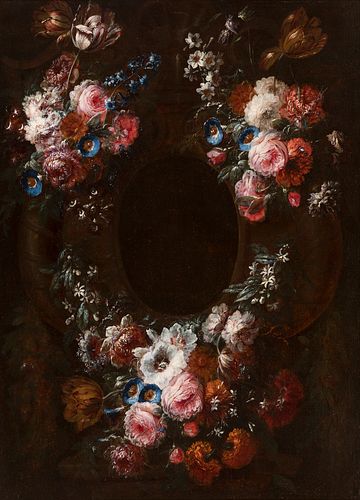JEAN-BAPTISTE MOREL (Antwerp, 1662-1732); last third of the 17th century. Orla de flores" ("Flower border"). Oil on canvas, Re linen backed. Signed
Lot 104
About Seller
Setdart Auction House
Carrer Aragó 346
Barcelona
Spain
Setdart Subastas was born in 2004 and is currently the first online art auction in Spain with solidity, prestige and reliability guaranteed by our more than 60,000 users. Setdart has a young, dynamic and enterprising team ready to successfully manage the purchase and sale of art works through custom...Read more
Estimate:
EUR€36,000 - EUR€38,000
$37,500 - $39,583.33
Absentee vs Live bid
Two ways to bid:
- Leave a max absentee bid and the platform will bid on your behalf up to your maximum bid during the live auction.
- Bid live during the auction and your bids will be submitted real-time to the auctioneer.
Bid Increments
| Price | Bid Increment |
|---|---|
| EUR€0 | EUR€10 |
| EUR€200 | EUR€25 |
| EUR€500 | EUR€50 |
| EUR€1,000 | EUR€100 |
| EUR€3,000 | EUR€200 |
| EUR€5,000 | EUR€500 |
| EUR€10,000 | EUR€1,000 |
| EUR€20,000 | EUR€2,000 |
| EUR€50,000 | EUR€5,000 |
About Auction
By Setdart Auction House
Oct 20, 2021
Set Reminder
2021-10-20 07:30:00
2021-10-20 07:30:00
America/New_York
Bidsquare
Bidsquare : OLD MASTERS
https://www.bidsquare.com/auctions/setdart-auction-house/old-masters-7700
Setdart Auction House sofia@setdart.com
Setdart Auction House sofia@setdart.com
- Lot Description
JEAN-BAPTISTE MOREL (Antwerp, 1662-1732); last third of the 17th century. Orla de flores" ("Flower border"). Oil on canvas, Re linen backed. Signed in the lower central area. It has a French frame from the beginning of the 18th century. Measurements: 109 x 79 cm; 134 x 104 cm (frame). The floral repertoire that is combined in the work offers an attractive variety, identifying a good number of species: tulips, anemones, roses and chrysanthemums, among other floral species. The wide range of colours in the black background that forms the whole composition is a striking feature of the work. It should be noted that behind the flowers, especially in the central area, there is a dark-toned oval frame that serves as the base for the floral wreath that dominates the scene. Despite the chromatic variety of the flowers, it should be noted that the artist has used darker and even ochre tones in the flowers around the outer perimeter of the composition. This indicates that the artist has used a spotlight that shines directly into the centre of the composition, leaving the side areas in a certain semi-darkness. During the 17th century a new formula developed in Flemish painting, deriving from the genre of flower painting, which was recreated by a large group of artists and workshops and achieved considerable success throughout the century in much of Europe: the garland of flowers as a framing and enhancing element for a central theme of a religious nature. Brueghel de Velours, known as Brueghel the Elder, was the initiator of this type of composition, particularly linked in his work to the depiction of the Virgin and Child. However, it was his disciple, the Jesuit Daniel Seghers, who was the dominant figure in this specialised production and the creator of a prototype that would serve as a model for the numerous Flemish and foreign followers and imitators of the genre. It should be noted that in this type of composition the flowers are not simply a secondary or accessory element, but are worked with the same care and of the same quality as the image they usually frame. In fact, on occasions they even reveal a more skilful hand, as these works were often the result of the collaboration between a painter of flowers and another who specialised in the human figure. In this particular work a great deal of skill can be seen in the floral composition, while in the centre the space is empty, so it is very likely that the piece is still unfinished. Jan Baptiste Morel began his artistic training in the studio of the still-life painter Nicolaes van Verendael. After his studies he specialised as a painter of still lifes, particularly of flowers and garlands. Due to his recognition as an artist, Morel was summoned to Brussels by the governor Maximilian II Emanuel to work on the decoration of various buildings in the city. It was at this time, in 1669, that he joined the Guild of Saint Luke in Brussels. In 1710 he returned to his native city of Antwerp, although he eventually settled in Brussels again, where it is thought he died.
- Shipping Info
-
In-house shipping available. Please inquire at admin@setdart.com.
-
- Buyer's Premium



 EUR
EUR CAD
CAD AUD
AUD GBP
GBP MXN
MXN HKD
HKD CNY
CNY MYR
MYR SEK
SEK SGD
SGD CHF
CHF THB
THB








